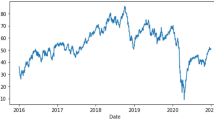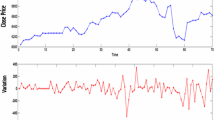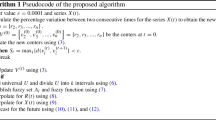Abstract
Fuzzy set based time series (FTS) prediction techniques offer potential advantages in efficient and intuitive data partitioning and the effective handling of uncertainty in the data. However, such prediction models are commonly challenging to design, requiring careful and application-specific tuning of hyperparameters to provide competitive forecasting performance. We propose SODA-T2FTS, a univariate non-parametric interval type-2 fuzzy set based time series prediction model that combines the capacity of interval type-2 fuzzy sets to effectively model variations in uncertainty, with the data-driven partitioning capabilities of the Self-Organised Direction Aware Data partitioning algorithm (SODA). We detail and evaluate the proposed model in terms of the average number of rules (c.f. interpretability), error metrics, execution time, model complexity and noise sensitivity. We use three financial time series: TAIEX, NASDAQ, and S&P500, to compare the proposed approach to other prediction methods in the literature. Results show that SODA-T2FTS obtained the lowest errors in all experiments, including the ones where noise was added to the original time series, suggesting that the forecasting model can predict complex time series with high accuracy using a data-driven approach independent of user interference. In addition to outperforming in accuracy, the proposed method presents a similar number of fuzzy rules in comparison to other FTS methods, thus, delivering better performance for comparable linguistic interpretability.








Similar content being viewed by others
Data availibility statement
Availability of data and material: TAIEX, NASDAQ and S&P500 data sets are available in: https://github.com/arthurcaio92/SODA-T2FTS.
Code availability
Source codes and examples: https://github.com/arthurcaio92/SODA-T2FTS.
References
Abhishekh GSS, Singh S (2018) A refined weighted method for forecasting based on type 2 fuzzy time series. Int J Model Simulat 38(3):180–188
Aladag CH, Yolcu U, Egrioglu E, Bas E (2014) Fuzzy lagged variable selection in fuzzy time series with genetic algorithms. Appl Soft Comput 22:465–473
Alyousifi Y, Othman M, Sokkalingam R, Faye I, Silva PC (2020) Predicting daily air pollution index based on fuzzy time series markov chain model. Symmetry 12(2):293
Angelov PP, Gu X, Príncipe JC (2018) A generalized methodology for data analysis. IEEE Trans Cybern 48(10):2981–2993
Askari S, Montazerin N (2015) A high-order multi-variable fuzzy time series forecasting algorithm based on fuzzy clustering. Expert Syst Appl 42(4):2121–2135
Askari S, Montazerin N, Zarandi MF (2020) Modeling energy flow in natural gas networks using time series disaggregation and fuzzy systems tuned by particle swarm optimization. Appl Soft Comput 92:106332
Bajestani NS, Zare A (2011) Forecasting taiex using improved type 2 fuzzy time series. Expert Syst Appl 38(5):5816–5821
Bisht K, Kumar S (2016) Fuzzy time series forecasting method based on hesitant fuzzy sets. Expert Syst Appl 64:557–568
Bose M, Mali K (2019) Designing fuzzy time series forecasting models: a survey. Int J Approx Reason 111:78–99
Castillo O, Amador-Angulo L, Castro JR, Garcia-Valdez M (2016) A comparative study of type-1 fuzzy logic systems, interval type-2 fuzzy logic systems and generalized type-2 fuzzy logic systems in control problems. Inform Sci 354:257–274
Chen MY, Chen BT (2015) A hybrid fuzzy time series model based on granular computing for stock price forecasting. Inform Sci 294:227–241
Chen SM, Phuong BDH (2017) Fuzzy time series forecasting based on optimal partitions of intervals and optimal weighting vectors. Knowl Based Syst 118:204–216
Chen SM et al (1996) Forecasting enrollments based on fuzzy time series. Fuzzy Sets Systems 81(3):311–319
Cheng CH, Chen TL, Chiang CH (2006) Trend-weighted fuzzy time-series model for taiex forecasting. In: Proceedings of the International Conference on Neural Information Processing, pp 469–477
Cheng SH, Chen SM, Jian WS (2016) Fuzzy time series forecasting based on fuzzy logical relationships and similarity measures. Inform Sci 327:272–287
Dincer NG, Akkuş Ö (2018) A new fuzzy time series model based on robust clustering for forecasting of air pollution. Ecol Inform 43:157–164
Duran K, Bernal H, Melgarejo M (2008) Improved iterative algorithm for computing the generalized centroid of an interval type-2 fuzzy set. In: Proceedings of the Annual Meeting of the North American Fuzzy Information Processing Society, pp 1–5
Ewbank H, Roveda JAF, Roveda SRMM, Irio Ribeiro A, Bressane A, Hadi-Vencheh A, Wanke P (2020) Sustainable resource management in a supply chain: a methodological proposal combining zero-inflated fuzzy time series and clustering techniques. J Enterp Inform Manag 33(5):1059–1076
Gao R, Duru O (2020) Parsimonious fuzzy time series modelling. Expert Syst Appl 156:113447
Gaxiola F, Melin P, Valdez F, Castillo O (2014) Interval type-2 fuzzy weight adjustment for backpropagation neural networks with application in time series prediction. Inform Sci 260:1–14
Gu X, Angelov PP, Kangin D, Principe JC (2018) Self-organised direction aware data partitioning algorithm. Inform Sci 423:80–95
Guo H, Pedrycz W, Liu X (2019) Fuzzy time series forecasting based on axiomatic fuzzy set theory. Neural Comput Appl 31(8):3921–3932
Gupta KK, Kumar S (2019a) Fuzzy time series forecasting method using probabilistic fuzzy sets. In: Proceedings of the Advanced Computing and Communication Technologies, pp 35–43
Gupta KK, Kumar S (2019b) A novel high-order fuzzy time series forecasting method based on probabilistic fuzzy sets. Granular Comput 4(4):699–713
Hieu ND, Ho NC, Lan VN (2020) Enrollment forecasting based on linguistic time series. J Comput Sci Cybern 36(2):119–137
Hua Q, Zhang Y, Wei L, Jihong Z (2019) A robust fuzzy time series forecasting method based on multi-partition and outlier detection. Chin J Electron 28(5):899–905
Huarng K, Yu HK (2005) A type 2 fuzzy time series model for stock index forecasting. Physica A: Stat Mech Appl 353:445–462
Hwang JR, Chen SM, Lee CH (1998) Handling forecasting problems using fuzzy time series. Fuzzy Sets Syst 100(1–3):217–228
Ismail Z, Efendi R (2011) Enrollment forecasting based on modified weight fuzzy time series. J Artifi Intell 4(1):110–118
Izakian H, Pedrycz W, Jamal I (2015) Fuzzy clustering of time series data using dynamic time warping distance. Eng Appl Artif Intell 39:235–244
Jiang JA, Syue CH, Wang CH, Wang JC, Shieh JS (2018) An interval type-2 fuzzy logic system for stock index forecasting based on fuzzy time series and a fuzzy logical relationship map. IEEE Access 6:69107–69119
Karnik NN, Mendel JM (1999) Applications of type-2 fuzzy logic systems to forecasting of time-series. Inform Sci 120(1–4):89–111
Karnik NN, Mendel JM (2001) Centroid of a type-2 fuzzy set. Inform Sci 132(1–4):195–220
Kumar N, Susan S (2021) Particle swarm optimization of partitions and fuzzy order for fuzzy time series forecasting of covid-19. Appl Soft Comput 110:107611
Lahmiri S (2020) A predictive system integrating intrinsic mode functions, artificial neural networks, and genetic algorithms for forecasting s&p500 intra-day data. Intell Syst Acc Fin Manag 27(2):55–65
Lee LW, Wang LH, Chen SM, Leu YH (2006) Handling forecasting problems based on two-factors high-order fuzzy time series. IEEE Trans Fuzzy Syst 14(3):468–477
Li R, Hu Y, Liang Q (2020) T2f-lstm method for long-term traffic volume prediction. IEEE Trans Fuzzy Syst 28(12):3256–3264
Liang Q, Mendel JM (2000) Interval type-2 fuzzy logic systems: theory and design. IEEE Trans Fuzzy Syst 8(5):535–550
Liu CF, Yeh CY, Lee SJ (2012) Application of type-2 neuro-fuzzy modeling in stock price prediction. Appl Soft Comput 12(4):1348–1358
Liu X, Wan S (2019) Combinatorial iterative algorithms for computing the centroid of an interval type-2 fuzzy set. IEEE Trans Fuzzy Syst 28(4):607–617
Luo C, Tan C, Zheng Y (2019) Long-term prediction of time series based on stepwise linear division algorithm and time-variant zonary fuzzy information granules. Int J Approx Reason 108:38–61
Mahmoudi MR, Mahmoudi M, Pak A (2019) On comparing, classifying and clustering several dependent regression models. J Stat Comput Simul 89(12):2280–2292
McCulloch J, Wagner C (2020) On the choice of similarity measures for type-2 fuzzy sets. Inform Sci 510:135–154
Mendel JM (2007) Type-2 fuzzy sets and systems: an overview. IEEE Comput Intell Mag 2(1):20–29
Mendel JM, Liu F (2007) Super-exponential convergence of the Karnik–Mendel algorithms for computing the centroid of an interval type-2 fuzzy set. IEEE Trans Fuzzy Syst 15(2):309–320
Mendel J, Hagras H, Tan WW, Melek WW, Ying H (2014) Introduction to type-2 fuzzy logic control: theory and applications. Wiley, Hoboken
Mukminin US, Irawanto B, Surarso B (1943) Farikhin (2021) Fuzzy time series based on frequency density-based partitioning and k-means clustering for forecasting exchange rate. J Phys Conf Ser 1:012119
Ng CT, Lee W, Lee Y (2020) Logical and test consistency in pairwise multiple comparisons. J Stat Plan Inference 206:145–162
Niu T, Wang J, Lu H, Yang W, Du P (2020) Developing a deep learning framework with two-stage feature selection for multivariate financial time series forecasting. Expert Syst Appl 148:113237
Pekaslan D, Wagner C, Garibaldi JM (2019) Adonis-adaptive online nonsingleton fuzzy logic systems. IEEE Trans Fuzzy Syst 28(10):2302–2312
Peng HW, Wu SF, Wei CC, Lee SJ (2015) Time series forecasting with a neuro-fuzzy modeling scheme. Appl Soft Comput 32:481–493
Rubio A, Bermúdez JD, Vercher E (2017) Improving stock index forecasts by using a new weighted fuzzy-trend time series method. Expert Syst Appl 76:12–20
Sadaei HJ (2013) Improved models in fuzzy time series for forecasting. PhD thesis, Universiti Teknologi Malaysia
Severiano CA, Silva PC, Sadaei HJ, Guimarães FG (2017) Very short-term solar forecasting using fuzzy time series. In: Proceedings of the IEEE international conference on fuzzy systems (FUZZ-IEEE), pp 1–6
Shukla AK, Muhuri PK (2019) Big-data clustering with interval type-2 fuzzy uncertainty modeling in gene expression datasets. Eng Appl Artif Intell 77:268–282
Shumway RH, Stoffer DS (2017) Time series analysis and its applications: with R examples. Springer, Berlin
Silva PCdL, Sadaei HJ, Ballini R, Guimarães FG (2019) Probabilistic forecasting with fuzzy time series. IEEE Trans Fuzzy Syst 28(8):1771–1784
Silva GR, Neto PC, Torres LC, Braga AP (2020a) A fuzzy data reduction cluster method based on boundary information for large datasets. Neural Comput Appl 32(24):18059–18068
Silva PC, e Lucas PdO, Sadaei HJ, Guimarães FG, (2020b) Distributed evolutionary hyperparameter optimization for fuzzy time series. IEEE Trans Netw Serv Manag 17(3):1309–1321
Singh P (2017) A brief review of modeling approaches based on fuzzy time series. Int J Mach Learn Cybern 8(2):397–420
Song Q, Chissom BS (1993) Fuzzy time series and its models. Fuzzy Sets Syst 54(3):269–277
Song X, Shi M, Wu J, Sun W (2019) A new fuzzy c-means clustering-based time series segmentation approach and its application on tunnel boring machine analysis. Mech Syst Signal Process 133:106279
Sun B, Guo H, Karimi HR, Ge Y, Xiong S (2015) Prediction of stock index futures prices based on fuzzy sets and multivariate fuzzy time series. Neurocomputing 151:1528–1536
Tak N (2020) Type-1 possibilistic fuzzy forecasting functions. J Comput Appl Math 370:112653
Tang J, Li L, Hu Z, Liu F (2019) Short-term traffic flow prediction considering spatio-temporal correlation: a hybrid model combing type-2 fuzzy c-means and artificial neural network. IEEE Access 7:101009–101018
Tsai MC, Cheng CH, Tsai MI (2019) A multifactor fuzzy time-series fitting model for forecasting the stock index. Symmetry 11(12):1474
Vamitha V (2021) A different approach on fuzzy time series forecasting model. Mater Today Proc 37:125–128
Vargas e Pinto AC, de Lima Silva PC, Guimarães FG, Wagner C, Aguiar EP (2021) Self-organised direction aware data partitioning for type-2 fuzzy time series prediction. In: Proceedings of the IEEE International Conference on Fuzzy Systems (FUZZ-IEEE), pp 1–6
Wang J, Li H, Lu H (2018) Application of a novel early warning system based on fuzzy time series in urban air quality forecasting in china. Appl Soft Comput 71:783–799
Wu D, Nie M (2011) Comparison and practical implementation of type-reduction algorithms for type-2 fuzzy sets and systems. In: Proceedings of the IEEE International Conference on Fuzzy Systems (FUZZ-IEEE), pp 2131–2138
Ye F, Zhang L, Zhang D, Fujita H, Gong Z (2016) A novel forecasting method based on multi-order fuzzy time series and technical analysis. Inform Sci 367:41–57
Yu HK (2005) Weighted fuzzy time series models for taiex forecasting. Physica A Stat Mech Appl 349(3–4):609–624
Zadeh LA (1975) The concept of a linguistic variable and its application to approximate reasoning-iii. Inform Sci 9(1):43–80
Zhang E, Wang D, Li H (2016) A comprehensive high order type 2 fuzzy time series forecasting model. In: Proceedings of the Chinese Control and Decision Conference (CCDC), pp 6681–6686
Zhao A, Gao J, Guan H (2020) Forecasting model for stock market based on probabilistic linguistic logical relationship and distance measurement. Symmetry 12(6):954
Funding
We thank CAPES (Financing Code 001), CNPq (Grant nos. 433389/2018-4 and 312991/2020-7), FAPEMIG (Grant APQ-02922-18) and the Federal University of Juiz de Fora - UFJF for the financial support.
Author information
Authors and Affiliations
Contributions
ACVP and EPdA contributed to conceptualization. ACVP, TEF and PCLS contributed to software design. EPdA contributed to funding acquisition and overall supervision. All authors contributed to manuscript writing and read and approved the final manuscript.
Corresponding author
Ethics declarations
Conflict of interest
The authors declare that they have no conflict of interest.
Ethical approval
This article does not contain any studies with human participants or animals performed by any of the authors.
Informed consent
Informed consent was obtained from all individual participants included in the study.
Additional information
Publisher's Note
Springer Nature remains neutral with regard to jurisdictional claims in published maps and institutional affiliations.
Rights and permissions
About this article
Cite this article
Pinto, A.C.V., Fernandes, T.E., Silva, P.C.L. et al. Interval type-2 fuzzy set based time series forecasting using a data-driven partitioning approach. Evolving Systems 13, 703–721 (2022). https://doi.org/10.1007/s12530-022-09452-2
Received:
Accepted:
Published:
Issue Date:
DOI: https://doi.org/10.1007/s12530-022-09452-2




